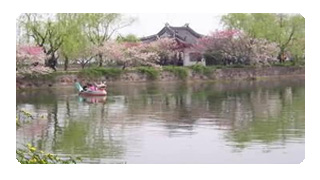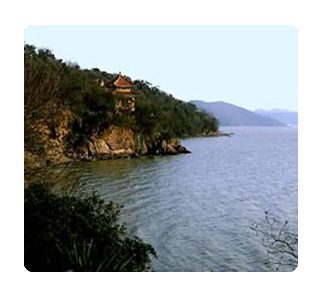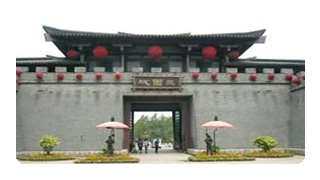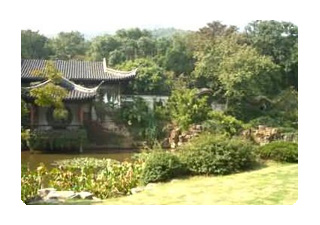Wuxi is outstanding for its natural
beauty and scenic spots, including Tai Lake, Lihu Lake
Park, the eco-friendly Yixing with its intriguing caves,
bamboo forests, tea plantations, Jiangyin, and the birth-place
of the great geographer and traveler Xu Xiake.
Near Tai Lake visitors can also enjoy the beauty and
tranquility of Li Garden, and closer to the city, Li
Garden on the shores of the smaller Li Lake. At 88 meters
in height, the towering bronze Ling Shan Buddha at Ma
Shan is another one of Wuxi's most spectacular sites.
Very close to the city center is the hilly area of Xihui
Park, which contains many attractions sych as a small
zoo, a cable car ride, and a pottery museum. Xihui Park
is located just across the Grand Canal, the largest
and busiest canal that crisscrosses the city.
Wuxi is located at the center of China's Yangtze Delta
128 km from Shanghai, just north of Tai Lake. It is
a major industrial city south of the Yangtze, a 'land
of fish and rice', and a famous tourist destination.
Wuxi is listed as one of the 15 central economic cities
of China and one of its top ten tourist cities. There
is ample accommodation available in the city at very
reasonable rates in the New District.
 Li
Garden
Li
Garden
Li Garden, located in Qingqi village of Wuxi, is a major
Chinese tourist attraction. The garden sweeps over 8.2
hectares (approx. 98,071 sq yards). This garden is named
after Li Lake, which was named after Fan Li, the prime
minister of Yue State around (770BC -476BC). After helping
the king conquer states of China, he lived near Li Lake
with Xi Shi (one of the four famously beautiful women
of ancient China).
Li Garden borders water on three sides with views of
rolling green hills in the distance. It is divided into
three sections: the middle section with artifical hill,
the west section with Four Seasons Pavilion and the
east section full of corridors. The manmade hills in
the middle section although varies in shapes and styles,
are all magnificently beautiful. The Four Seasons Pavilion
in the west section is actually four pavilions, one
for each season. They are all built in the same style
with flowers unique to each seaon painted on the pillars.
Each pavilion also features one special type of flowers
planted inside. The Spring and Autumn pavilions are
the tallest structures of the garden at three stories
tall and provides a great view of the entire garden.
From June to September, there is an exhibition of the
lotus flower.
From July to September, night tours are also offered.
 Turtle
Head Island
Turtle
Head Island
The Taihu Lake, located in southern Yangtze River
delta, is the third largest freshwater lake in China
with an area of 2,338 sq. km. (about 902 sq. miles)
and an average depth of 2 m (7ft). Taihu Lake is nationally
known for its scenery. On any given day, you can look
out over Taihu Lake to see it dotted with islands,
fishing boats and little row boats.
Taihu lake also has many uniquedly shaped limestones
at its bed which are used today in many classic Chinese
gardens. In fact, legend has it that the emperor of
the Song dynasty, Huizong, nearly bankrupted the country
trying to find the most strangely shaped Taihu rocks!
Besides fascinating rocks, Taihu Lake also provides
many types of fish for local fish lovers. The famous
dish 'Taihu Lake Three Whites' is made with white
fish and shrimp from the lake. This dish is usually
served on a boat flowing peacefully in Taihu Lake.
This offers a very unique experience paired with a
trip to the lake's Yuantouzhu (Turtle Head Island)
peninsula, the lakes hottest attraction.
Turtle Head Island occupies the most beautiful place
of Lake Tai. It is actually a peninsula that resembles
a turtle head and extends into the northwestern part
of Tai Lake, about 8km from Wuxi. Inside the park
are ten famous scenic spots, which include Chongshan
Garden, Jiangnan Orchid Garden, Taihu Fairy Islet,
and Guangfu Temple.
 Lingshan
Grand Buddha
Lingshan
Grand Buddha
The Lingshan Grand Buddha is located 10 kilometers
southwest of Wuxi near the shores of Lake Tai. It
stands 88 meters tall and boasts the tallest standing
Buddha in the world. It was built in October 1994
on the original site of Xiangfo Temple, and more than
700 tons of copper was used in casting it.
The statue represents Sakyamuni, founder of Buddhism,
and was based on records from the Buddhist scriptures.
It is a national art treasure that integrates culture,
art, and religion. The Grand Buddha is merciful and
looks upon all living creatures with a blessing and
a smile. The gesture of the Buddha's right hand represents
the banishment of pain and suffering and the gesture
of his left hand respresents the act of rendering
happiness.
 Three
Kingdoms City
Three
Kingdoms City
Located along the banks of Tai Lake, these three cities
were recently used as TV production sets and have
now been transformed into tourist attractions. Tang
City, the oldest of the three, was the set of a late
1980s television drama about a Tang Dynasty emperor.
Three Kingdoms City was the set of the wildly popular
series 'Romance of the Three Kingdoms.' The city covers
35 hectares (86 acres) and was built in 1993. It was
designed completely in the style typical of the Han
dynasty. Following the success of the series, the
city has become a tourist hotspot. The third is Water
Margin City; set of the TV series 'Water Margin City.'
 Xihui
Park
Xihui
Park
The Xihui Park is located near Wuxi, about 2.5 kilometers
west of the city. This park was named after two hills
that are located here: Xi Hill and Hui Hill. Xihui
Park is the largest comprehensive public park in the
Wuxi area, covering an area of 6.85 square kilometers.
Centered on Yinshan Lake, the park includes eighteen
major historical and cultural sites, an amusement
park, Wuxi Zoo, and a TV production set, which can
all be reached by cable car. Another attraction in
the park is the Longguang Pagoda, which boasts a history
of 400 years and stands at the top of Xishan Hill.
Looking out from the pagoda, you will have a panoramic
view of Wuxi's landscape.
According to historical records, Emperor Kangxi and
Emperor Qianlong in the Qing Dynasty came to Xihui
Park while they were traveling in south China. Emperor
Qianlong was so fond of the scenery in Pleasure Garden
that he ordered an identical garden be built in the
Summer Palace, named Garden of Harmonious Interests.



